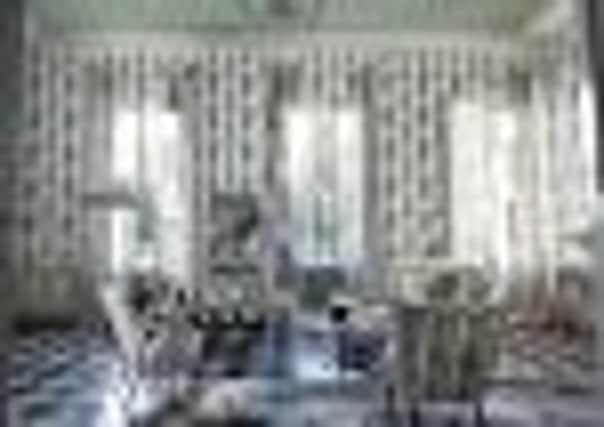Get it down on paper


It seems that the interior world’s appetite for wallpaper continues to grow and grow. The last decade has seen it transform from something vaguely passé to a key element in many design schemes.
I favour wallpaper over a painted finish in my room designs as I consider that the overall effect is generally much softer and, if treated correctly, wallpaper is incredibly resilient giving a good finish that will last for years.
Advertisement
Hide AdAdvertisement
Hide AdOne of the emerging themes in wallpaper this Spring are recollections of the “Grand Tour” and early explorers. Several ranges feature soft graphics reminiscent of historical printing techniques or the pencil drawings of the pioneering travellers who first began to map the globe.


Cartography, calligraphy and mathematical symbols also feature in a number of collections which nod in the direction of early scientific discoveries.
The Intaglio Collection from Zoffany (www.zoffany.com – 0844 543 4748) is named after an early method of printing where ink is wiped into recesses or troughs on the printing plate – in contrast to relief printing where raised surfaces are inked up for printing. The collection features a range of non-woven papers featuring exquisite maps of London taking from an original design on a silk handkerchief dating back to 1832, which build to form a beautiful pattern that only reveals its origins on close inspection (£48 per roll). There are also a number of beautiful architectural representations including Facade which was inspired by the pen and ink drawings of the great Renaissance architect, Andrea Palladio (£48 per roll).
The Navigator Collection from Andrew Martin (www.andrewmartin.co.uk – 020 7225 5100) also features wonderful early UK maps in their Traveller design (£39.90 per roll) and an intriguing array of handwritten mathematical calculations in Pythagoras (£39.90 per roll) which is available in a selection of muted backgrounds – the perfect solution for a home study.
Advertisement
Hide AdAdvertisement
Hide AdOsborne and Little (www.osborneandlittle.com – 020 7352 1456) has introduced the Grand Tour collection inspired by the artistic and architectural treasures of Italy, as reported by aristocratic Englishmen on the Grand Tour of Europe. Laguna features monochrome storks, straight out of an artist’s sketch book (£46 per roll). In contrast, Loggia is an innovative holographic foil print of an Italianate staircase rendered in black and silver which results in a design, initially puzzling to the eye, but ultimately visually stunning (£78 per roll).


The Linnaeus collection from Designers Guild (www.designersguild.co.uk – 020 7351 5775) returns to the sketch books of the early tourists with finely drawn graphics and restrained elegance. The topiary sketches in the Linnaeus design are restfully simple single colour renditions on a plain white background (£45 per roll). Bergius features a strong contemporary classical design (£45 per roll).
In general, I use wallpaper to contribute to a scheme, rather than dominate it: choosing colours or designs that pick up on the key elements of the room, without imposing too much of their own personality.
When choosing a design, it is important to consider the overall proportions of your room. If you are opting for a large pattern, ensure that your room is big enough to cope with it.
Advertisement
Hide AdAdvertisement
Hide AdIf you are worried about wear and tear in high traffic or areas with limited space (such as staircases), then it is a good idea to opt for gloss finish or vinyl wallpapers that tend to be more hardwearing. However, you can also use a protective water based decorator’s varnish which can be applied on top of the paper to provide a more resistant surface.
Hanging your wallpaper correctly is vital – edges need to butt together and it is important to pay attention when matching the pattern repeat to ensure that the end result is seamless, rather than appearing to be a selection of disjointed panels. Never skimp on wallpaper paste – it is worth paying for a good quality solvent.
If applying paste strikes dread into you, look for non-woven wallpapers. These allow you to put the paste directly on the wall and then apply the dry paper, making the task considerably easier (and allowing you the flexibility of manoeuvring the paper a little more).
Ultimately, wallpapering is one of those tasks where it really is worth getting in a professional if you are unsure of your capability. After all, when you look at the cost of each roll it really does make sense to get it right first time.
Advertisement
Hide AdAdvertisement
Hide AdJamie Hempsall is an award winning interior design and member of the British Institute of Interior Design. Contact him via his website www.jamiehempsall.com or call him on 0800 032 1180.
WALL COVERINGS THAT WEAVE A DIFFERENT SPELL
Non-woven wall-coverings are being introduced into an increasing number of ranges. They are usually constructed from a special blend of natural and synthetic fibres (which are found in many household products such as tea bags, coffee filters, and gauze).
This means that the majority of them are washable and breathable, making them particularly suitable for application in kitchens and bathrooms and an ideal candidate for areas where they are likely to incur more wear and tear.
Non-woven wall-coverings are also usually more tear-resistant than traditional papers, so they are less likely to get torn during installation or removal.